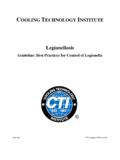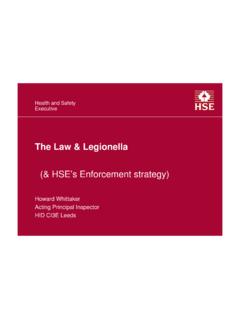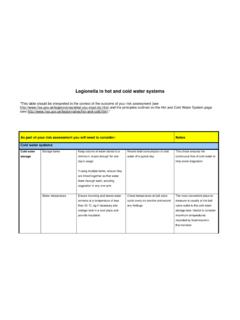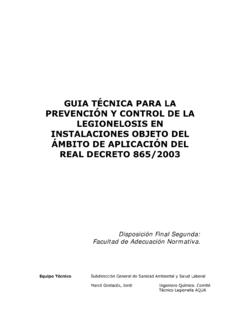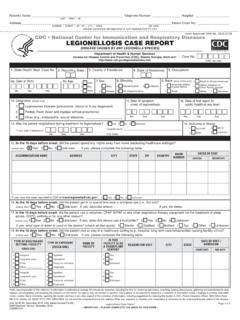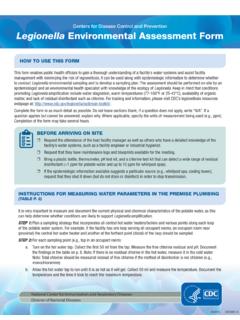Transcription of LEGIONELLA - WHO
1 LEGIONELLA . and the prevention of legionellosis LEGIONELLA AND THE PREVENTION OF LEGIONELLOSIS . WHO Library Cataloguing-in-Publication Data world health organization LEGIONELLA and the prevention of legionellosis 1. LEGIONELLA 2. Legionellosis prevention and control 3. Legionnaires' disease prevention and control 4. Water supply 5. Swimming pools 6. health facilities 7. Ships outbreaks prevention and control I. Title ISBN 92 4 156297 8 (NLM classification: WC 200). world health organization 2007. All rights reserved. Publications of the world health organization can be obtained from WHO Press, world health organization , 20 Avenue Appia, 1211 Geneva 27, Switzerland (tel: +41 22 791 2476; fax: +41 22 791. 4857; e mail: Requests for permission to reproduce or translate WHO publications . whether for sale or for noncommercial distribution should be addressed to WHO Press at the above address (fax: +41 22 791 4806; e mail: The designations employed and the presentation of the material in this publication do not imply the expression of any opinion whatsoever on the part of the world health organization concerning the legal status of any country, territory, city or area or of its authorities, or concerning the delimitation of its frontiers or boundaries.))
2 Dotted lines on maps represent approximate border lines for which there may not yet be full agreement. The mention of specific companies or of certain manufacturers' products does not imply that they are endorsed or recommended by the world health organization in preference to others of a similar nature that are not mentioned. Errors and omissions excepted, the names of proprietary products are distinguished by initial capital letters. All reasonable precautions have been taken by the world health organization to verify the information contained in this publication. However, the published material is being distributed without warranty of any kind, either express or implied. The responsibility for the interpretation and use of the material lies with the reader. In no event shall the world health organization be liable for damages arising from its use. Printed in India Designed by Design ONE, Canberra. The cover is based on a scanning electron micrograph depicting the in situ structure of a nitrifying biofilm from a functioning biological filter.
3 The photograph, supplied by Dr Richard Bentham, was taken by Ben van den Akker, Flinders University, Adelaide, Australia, with the assistance of Flinders Microscope Imaging and Analysis Facility. ii LEGIONELLA AND THE PREVENTION OF LEGIONELLOSIS. LEGIONELLA . and the prevention of legionellosis Edited by: Jamie Bartram, Yves Chartier, John V Lee, Kathy Pond and Susanne Surman-Lee LEGIONELLA AND THE PREVENTION OF LEGIONELLOSIS iii iv LEGIONELLA AND THE PREVENTION OF LEGIONELLOSIS. Foreword Legionellosis is a collection of infections that emerged in the second half of the 20th century, and that are caused by LEGIONELLA pneumophila and related LEGIONELLA bacteria. The severity of legionellosis varies from mild febrile illness (Pontiac fever) to a potentially fatal form of pneumonia (Legionnaires' disease) that can affect anyone, but principally affects those who are susceptible due to age, illness, immunosuppression or other risk factors, such as smoking.
4 Water is the major natural reservoir for legionellae, and the bacteria are found worldwide in many different natural and artificial aquatic environments, such as cooling towers; water systems in hotels, homes, ships and factories; respiratory therapy equipment; fountains; misting devices; and spa pools. About 20% of the cases of legionellosis detected in Europe are considered to be travel- related; these cases present a particular set of problems because of difficulties in identifying the source of infection. The world health organization (WHO) currently provides guidance on LEGIONELLA risk assessment and management in three principal documents: Guidelines for Drinking-water Quality (WHO, 2004). Guidelines for Safe Recreational Water Environments (WHO, 2006). Guide to Ship Sanitation (WHO, 2007). As part of the ongoing review of the Guidelines for Drinking-water Quality, specific micro- organisms and chemicals are periodically evaluated, and documentation relating to protection and control of drinking-water quality is prepared.
5 In 2001, a meeting was held in Adelaide, Australia, to discuss approaches to regulating microbial drinking-water quality, and development of risk assessment and risk management approaches, for incorporation into the 3rd edition of the Guidelines for Drinking-water Quality (WHO, 2004). At that meeting, health concerns relating to LEGIONELLA were identified as an area of increasing public and professional interest. The meeting recommended the development of this publication LEGIONELLA and the Prevention of Legionellosis to review the current state of knowledge about the impact of LEGIONELLA on health . This book provides a comprehensive overview of the sources, ecology and laboratory identification of LEGIONELLA . It provides guidance on assessment and management of risks associated with potentially hazardous environments, such as cooling towers, pools and spa baths. The document also identifies necessary measures to prevent, or adequately control, the risk of exposure to LEGIONELLA bacteria for each particular environment.
6 Outbreaks of legionellosis generally cause a high level of morbidity and mortality in the people exposed; therefore, the suspicion of an outbreak warrants immediate action. This publication reviews policies and practice for outbreak management and the institutional roles and responsibilities of an outbreak control team. LEGIONELLA AND THE PREVENTION OF LEGIONELLOSIS . The development of this publication was guided by the recommendations of an expert meeting hosted by the health Protection Agency's Centre for Infections (formerly the Central Public health Laboratory), Colindale, London, on 18 20 June 2002, chaired by Dr John V Lee. It was also guided by a series of critical reviews undertaken by specialists in the field. The production of this document was led by the Department of Public health and Environment Programme on Assessing and Managing Environmental Risks to health at WHO, in cooperation with the Department of Epidemic and Pandemic Alert and Response at WHO.
7 This book will be useful to all those concerned with LEGIONELLA and health , including environmental and public health officers, health -care workers, the travel industry, researchers and special interest groups. vi LEGIONELLA AND THE PREVENTION OF LEGIONELLOSIS. Contents Foreword .. v Acknowledgements .. xvii Abbreviations and acronyms .. xx Executive summary .. xxi Chapter 1 Legionellosis .. 1. Types of disease .. 1. Legionnaires' disease.. 2. Pontiac fever.. 5. Extrapulmonary syndromes.. 5. Prevalence and risk factors.. 8. Community-acquired pneumonia.. 9. Nosocomial infections.. 10. Sporadic cases of pneumonia.. 13. Rates of mortality and survival .. 14. Treatment of Legionnaires' disease.. 15. Types of organism causing disease .. 18. Taxonomy.. 18. Species and serogroups associated with disease.. 19. Virulence and pathogenicity.. 22. Overview and life cycle.. 22. Surface structures involved in pathogenicity.
8 25. Virulence factors.. 25. Host defence.. 27. Transmission.. 27. Chapter 2 Ecology and environmental sources of LEGIONELLA .. 29. Natural sources of LEGIONELLA .. 29. Factors affecting growth of LEGIONELLA .. 30. Influence of temperature.. 30. LEGIONELLA AND THE PREVENTION OF LEGIONELLOSIS vii Effect of other microorganisms.. 31. Environmental factors and virulence.. 33. Biofilms .. 33. Biofilm composition.. 33. Biofilm formation.. 33. Effect of biofilms on bacteria growth.. 35. Risk factors for biofilm growth.. 36. Sources of LEGIONELLA infection .. 37. Disease spread via aerosols and inhalation.. 37. Disease spread via soil.. 38. Chapter 3 Approaches to risk management .. 39. Environmental exposure and disease.. 40. Cooling tower outbreaks.. 40. health -based targets.. 42. Water safety plans.. 43. System assessment.. 45. Monitoring.. 46. Management and communication.. 54. Surveillance .. 56. Chapter 4 Potable water and in-building distribution systems.
9 57. Background.. 57. Water safety plan overview.. 58. System assessment .. 60. Document and describe the system.. 61. Assess hazards and prioritize risks .. 61. Monitoring .. 64. Identify control measures .. 64. Monitor control measures.. 67. Management and communication.. 67. Prepare management procedures.. 67. Establish documentation and communication procedures.. 68. viii LEGIONELLA AND THE PREVENTION OF LEGIONELLOSIS. Chapter 5 Cooling towers and evaporative condensers .. 69. Background.. 69. Cross-flow cooling towers.. 71. Counterflow evaporative condensers and cooling towers.. 71. Links to outbreaks of legionellosis.. 71. Water safety plan overview.. 72. System assessment .. 75. Document and describe the system.. 75. Assess hazards and prioritize risks .. 75. Monitoring .. 77. Identify control measures .. 77. Monitor control measures.. 83. Management and communication.. 85. Develop supporting programs.. 85.
10 Prepare management procedures.. 86. Establish documentation and communication procedures.. 86. Verification.. 87. Surveillance .. 88. Chapter 6 health -care facilities.. 89. Background.. 89. Surveillance data on nosocomial Legionnaires' disease.. 90. Water safety plan overview.. 91. System assessment .. 93. Document and describe the system.. 93. Assess hazards and prioritize risks .. 94. Monitoring .. 96. Identify control measures .. 97. Monitor control measures.. 98. Management and communication.. 98. Prepare management procedures.. 99. Establish documentation and communication procedures .. 101. Verification.. 102. LEGIONELLA AND THE PREVENTION OF LEGIONELLOSIS ix Chapter 7 Hotels and ships.. 103. Background.. 103. European initiatives.. 103. Hotel-associated cases.. 105. Ship-associated cases.. 106. Water safety plan overview.. 109. System assessment .. 109. Document and describe the system.. 109. Assess hazards and prioritise risks.










